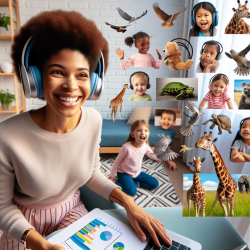Introduction
In the field of speech-language pathology, especially when working with children, the importance of evidence-based practices cannot be overstated. Drawing insights from diverse fields can enhance our understanding and improve outcomes. The research article "Who Cares About Wildlife?" by Michael J. Manfredo provides valuable insights into human-wildlife relationships and conservation issues, which can indirectly inform and enhance practices in speech-language pathology.
Understanding Human-Wildlife Relationships
The research highlights the complex relationships between humans and wildlife, emphasizing the importance of understanding these dynamics to foster better conservation efforts. This understanding can be paralleled in speech-language pathology, where comprehending the intricate interactions between a child and their environment is crucial for effective therapy.
Implementing Insights into Practice
Here are some ways practitioners can incorporate insights from wildlife conservation research into their practice:
- Holistic Understanding: Just as wildlife conservationists consider ecological systems, speech-language pathologists should adopt a holistic view of a child's communication environment, considering all influencing factors.
- Interdisciplinary Collaboration: The research underscores the value of interdisciplinary approaches. Collaborating with educators, psychologists, and other professionals can provide a more comprehensive understanding of a child's needs.
- Data-Driven Decisions: Emphasizing the importance of data in wildlife management, practitioners should rely on data-driven assessments to tailor interventions that meet each child's unique needs.
- Stakeholder Engagement: Engaging parents and caregivers in the therapy process is akin to involving local communities in conservation efforts, ensuring that interventions are supported and reinforced outside of therapy sessions.
Encouraging Further Research
The article also encourages further exploration into the social dimensions of wildlife management. Similarly, speech-language pathologists are encouraged to engage in continuous research to uncover new strategies and techniques that can enhance therapy outcomes. This can include exploring the impact of environmental factors on language development or investigating innovative therapeutic approaches.
Conclusion
By drawing parallels between wildlife conservation and speech-language pathology, practitioners can enhance their understanding and improve therapeutic outcomes for children. Embracing a holistic, data-driven, and collaborative approach can lead to more effective interventions and better support for children in their communication journey.
To read the original research paper, please follow this link: Who Cares About Wildlife?










